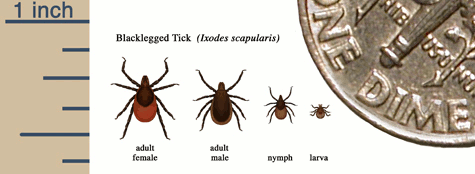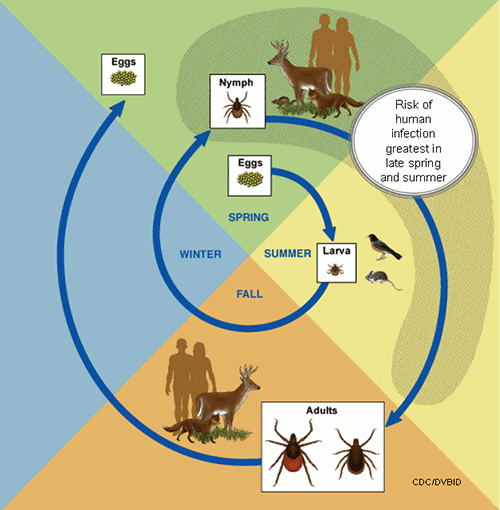Aetiology
Human tick-borne encephalitis (TBE) is caused by the TBE virus, a member of the family Flaviviridae, and was initially isolated in 1937. There are 4 subtypes of the TBE virus:[6]
Western/European subtype (previously called Central European encephalitis virus)
(Ural-) Siberian subtype
Far Eastern subtype (previously called Russian spring-summer encephalitis virus)
Louping ill subtype (previously called louping ill virus - or, in Japan, Negishi virus).
The viruses are transmitted by arthropod vectors, usually from the Ixodes genus of hard ticks.[1] Quick removal of the tick will reduce the chance of infection. However, transmission occurs from the saliva of an infected tick, and may occur early; hence, removing a tick promptly may not prevent disease progression.[14] At any one location, between 0.2% and 4% of ticks may be infected with TBE.[6] Human disease starts 4 to 28 days after a bite from an infected tick.[2] Small mammals and grouse, deer, and sheep are the vertebrate amplifiers of TBE viruses.[6]
The risk of human infection varies by geographical area, and can be highly localised within a given area.[6] Human TBE occurs focally throughout the northern hemisphere between April and October, with a peak in June and July.[6] The tick species that transmit TBE preferentially inhabit forests and woodlands with rich undervegetation, providing both humidity and shelter.[5] They are also found in forest glades and adjacent grasslands, and in meadows bordering rivers, lakes, and marshes.[5] Human infection usually follows either outdoor activities resulting in tick bites, or the consumption of raw (unpasteurised) milk or dairy products from infected animals.[3]
The arthropod vectors of TBE viruses are:[13]
Western/European subtype - mainly Ixodes ricinus ticks
(Ural-) Siberian subtype - mainly Ixodes persulcatus ticks
Far Eastern subtype - mainly I persulcatus ticks
Louping ill subtype - mainly I ricinus ticks.
Powassan virus (a related tick-borne flavivirus that can present with encephalitis) is transmitted as follows:[13]
In North America - by Ixodes species (primarily, Ixodes cookei and Ixodes scapularis)
In Russia - by I persulcatus and Haemaphysalis longicornis.
Other tick species that can transmit TBE are Ixodes gibbosus and, sporadically, Dermacentor, Haemaphysalis, and Hyalomma species).[6]
Raw (unpasteurised) milk seems to represent the main transmission route for louping ill viruses, which cause disease only very rarely.[6]
Direct person-to-person transmission is rare, occurring through blood transfusion, solid organ transplantation or breastfeeding.[3]
[Figure caption and citation for the preceding image starts]: Relative sizes of the Ixodes scapularis tick at different life stagesCDC [Citation ends].
[Figure caption and citation for the preceding image starts]: Life cycle of Ixodes scapularis that spreads TBECDC [Citation ends].
Pathophysiology
The median incubation period for tick-borne infection is 8 days (2-28 days).[3]
Encephalitis is an inflammatory process in the brain parenchyma. It is associated with clinical evidence of brain dysfunction due to infectious (usually viral) or non-infectious (usually autoimmune) processes. In viral encephalitis, the virus initially gains entry and replicates in local or regional tissue, such as the gastrointestinal tract, skin, urogenital system, or respiratory system. Subsequent dissemination to the central nervous system occurs. Depending on the interactions between the neurotropic properties of the virus and the host immune response (mediated by humoral antibodies, cytotoxic T cells, cytokines, and innate immunity of each neuronal subtype),[15] infection and inflammation of brain parenchyma occur. In these cases, neuronal involvement occurs along with evidence of a productive viral infection.
Classification
Flaviviruses transmitted by ticks
The family Flaviviridae includes several tick-borne viruses affecting humans. These include:
Tick-borne encephalitis virus (Europe, Siberia, and Far Eastern) - see below for more information on subtypes
Omsk haemorrhagic fever virus (Siberia)
Kyasanur Forest disease virus (India)
Alkhurma virus (Saudi Arabia)
Louping ill virus (UK)
Powassan virus (United States and Russia).
Tick-borne encephalitis viruses
Tick-borne encephalitis (TBE) viruses belong to the broad category of arboviral (arthropod-borne) encephalitides.[4] They are members of the genus Flavivirus within the family of Flaviviridae.[5] They are 50-nm, enveloped RNA viruses with an 11 kb genome encoding for a polyprotein of around 3400 amino acids.[5]
TBE viruses are currently subdivided into 4 taxonomic groups:[6]
Western/European subtype (previously called Central European encephalitis virus)
(Ural-) Siberian subtype
Far Eastern subtype (previously called Russian spring-summer encephalitis virus)
Louping ill subtype (previously called louping ill virus - or, in Japan, Negishi virus).
A related tick-borne flavivirus that causes encephalitis is Powassan virus.[4]
Use of this content is subject to our disclaimer